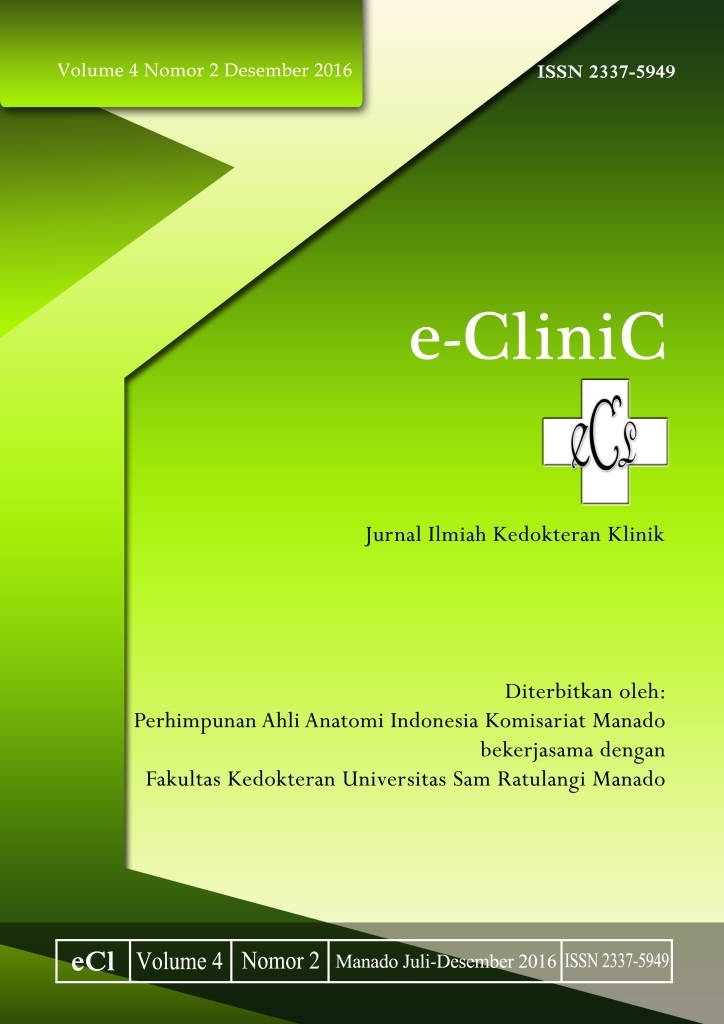Gambaran kadar troponin T berdasarkan waktu pemeriksaan dan lokasi infark pada pasien infark miokard akut di RSUP Prof Dr. R. D. Kandou periode Januari-Desember 2015
DOI:
https://doi.org/10.35790/ecl.v4i2.14465Abstract
Abstract: Acute myocardial infarction (AMI) causes high mortality and morbidity rates. AMI must be dealt quickly and efficiently for prolonged ischemia can cause irreversible damage and worsen the prognosis. The American College of Cardiology decided that the diagnosis of AMI required a combination of ischemic symptoms and/or electrocardiographic changes accompanied by myocardial necrosis markers, the biomarkers. Previous studies showed that there were variations in troponin levels based on examination time and location of infarction. This study was aimed to obtain the profile of troponin T levels based on time of troponin T examination and location of infarction in AMI patients at Prof. Dr. R. D. Kandou Hospital from January to December, 2015. This was a descriptive observational study with a retrospective approach. Samples were AMI patients with complete data that fulfilled the inclusion and exclusion criteria. The results showed that of the total 61 AMI patients there were 26 samples that fulfilled the criteria. The majority of samples were males, age group 55-64 years, and the risk factor was a combination of some of the major risk factors. Most infarctions of NSTEMI were dominated by anteroseptal and anterolateral infarct locations and levels of troponin T were in the range of >100-2000 ng / L (the average value of 475 ng / L). Levels of troponin T were influenced by the time of examination, but not by the location of the infarct.
Keywords: acute myocardial infarction, troponin T, examination time, infarct location
Â
Abstrak: Infark miokard akut (IMA) menyebabkan angka mortalitas dan morbiditas tinggi. IMA harus ditangani dengan cepat dan efisien karena iskemia yang berkepanjangan dapat menyebabkan kerusakan yang ireversibel dan menentukan prognosis. The American College of Cardiology menetapkan bahwa untuk diagnosis infark miokard akut diperlukan kombinasi antara gejala iskemik dan/atau perubahan elektrokardiografi disertai penanda nekrosis infark yaitu biomarker. Berdasarkan penelitian sebelumnya didapatkan variasi troponin berdasarkan waktu pemeriksaan dan lokasi infark. Penelitian ini bertujuan untuk mengetahui gambaran kadar troponin T berdasarkan waktu pemeriksaan troponin T dan lokasi infark pada pasien infark miokard akut di RSUP Prof. Dr. R. D. Kandou periode Januari-Desember 2015. Jenis penelitian ialah observasional deskriptif dengan pendekatan studi retrospektif. Sampel ialah pasien infark miokard akut dengan data lengkap yang memenuhi kriteria inklusi dan eksklusi, diambil dari rekam medik. Hasil penelitian memperlihatkan dari total 61 pasien IMA didapatkan 26 sampel yang memenuhi kriteria. Mayoritas sampel ialah laki-laki, kelompok usia 55-64 tahun, faktor risiko yaitu kombinasi dari beberapa faktor risiko mayor, jenis infark NSTEMI didominasi oleh lokasi infark anteroseptal dan anterolateral dengan lebih dari setengah jumlah sampel memiliki kadar troponin T pada rentang >100-2000 ng/L (nilai rerata 475 ng/L). Kadar troponin T dipengaruhi oleh waktu pemeriksaan tetapi tidak dipengaruhi oleh lokasi infark.
Kata kunci: infark miokard akut, troponin T, waktu pemeriksaan, lokasi infark
Downloads
How to Cite
Issue
Section
License
COPYRIGHT
Authors who publish with this journal agree to the following terms:
Authors hold their copyright and grant this journal the privilege of first publication, with the work simultaneously licensed under a Creative Commons Attribution License that permits others to impart the work with an acknowledgment of the work's origin and initial publication by this journal.
Authors can enter into separate or additional contractual arrangements for the non-exclusive distribution of the journal's published version of the work (for example, post it to an institutional repository or publish it in a book), with an acknowledgment of its underlying publication in this journal.
Authors are permitted and encouraged to post their work online (for example, in institutional repositories or on their website) as it can lead to productive exchanges, as well as earlier and greater citation of the published work (See The Effect of Open Access).







